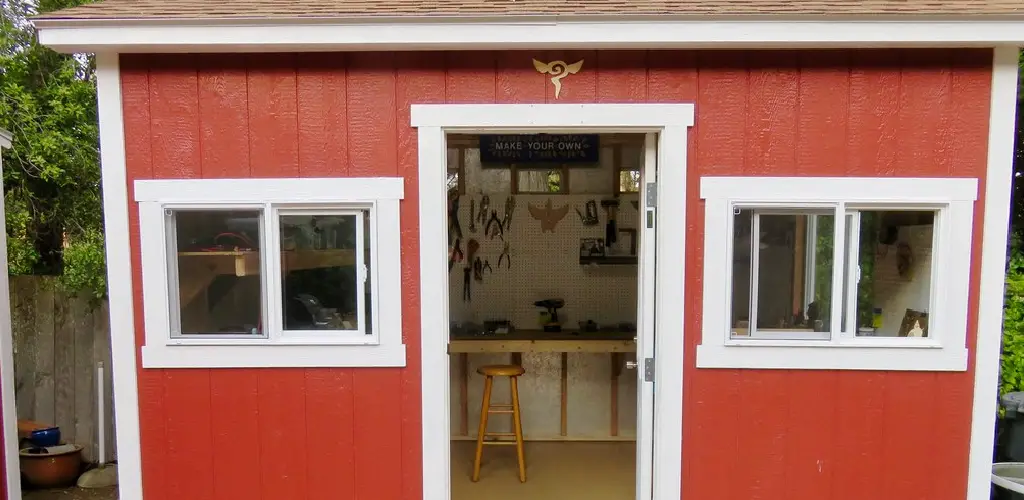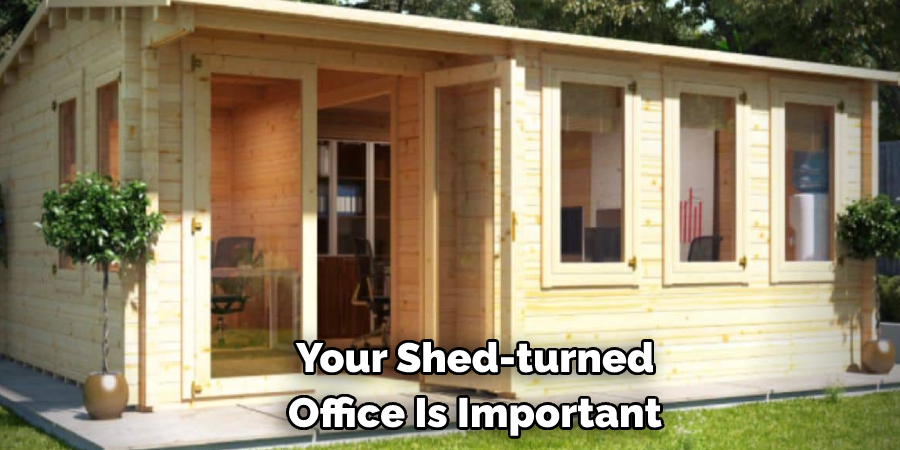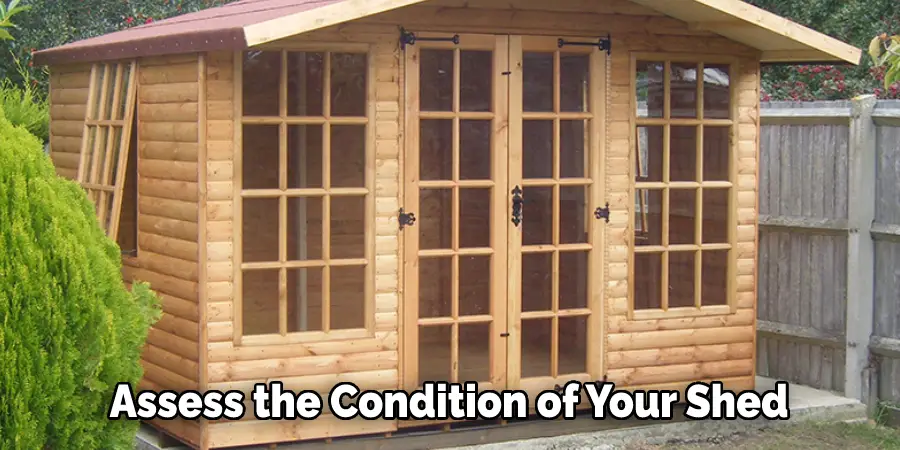If you’re like most people, you have a lot of stuff crammed into your home office. It can be hard to get anything done between the stacks of papers and the overflowing inbox. Maybe it’s time to consider moving your office out of the house and into a shed.

Yes, a shed! With a little bit of work, you can turn your shed into the perfect place to get things done. Check out these tips for turning your shed into an office. Keep reading to learn more about how to turn a shed into an office.
Why Should You Turn a Shed Into an Office?
Stop working from your couch and turn that old shed in the back into an office! It may sound daunting, but investing in your home office space is worth it. Here are four reasons why:
First, you can leave work at work when you have a designated office space. This is important for your mental and physical health- if reminders of your to-do list constantly surround you, you’re more likely to feel overwhelmed.
Second, an office gives you a place to spread out. If you’re working from your dining room table, the chances are good that your papers are constantly getting shuffled or misplaced. But with a desk and filing cabinet, you can keep everything organized and within reach.
Third, an office is a great place to host clients or colleagues. It can be difficult to find a professional space to meet with people if you’re working from home. But if you have an office, you can close the door and create a quiet, private atmosphere for meetings.
Finally, an office can be a tax deduction! If you use part of your home for business purposes, you may be able to deduct a portion of your rent or mortgage from your taxes.

So if you’re thinking about turning that shed into an office, go for it! It’s a great investment in your home and your business.
Things You’ll Need
- A shed
- Insulation
- Windows
- A door
- Drywall
- Paint or wallpaper
- Flooring
- Furniture
- Lighting
- Electrical outlets
How to Turn a Shed Into an Office Step by Step Guide
Step 1: Planning
The first step is to decide how you want to use the space and what kind of office you will need. For example, if you plan to use it for storage, you won’t need as much space or electrical outlets. However, if you plan to use it as a home office, you will need more space and outlets. You will also need to decide if you want to heat and cool the shed, affecting how you insulate it.
Step 2: Location
Choose a location for your shed that is close to your house. This will make it easy to get to and from, and you won’t have to worry about bad weather ruining your office space. If you have the room, build your shed near some trees or shrubs; this will create a more natural setting for you to work in.
Step 3: Choosing the Design
The design of your shed-turned-office is important for how you’ll use the space and how it will look from the outside. For example, if you plan on using your office as a private retreat, you may want to go for a more secluded design that doesn’t have any windows. On the other hand, if you want your office to double as a guest house, you’ll want a bathroom and kitchen design.

When it comes to the exterior, you’ll want to make sure that your office blends in with the rest of your home. This means choosing a style that matches the rest of your house and using similar materials. For example, if your house is a bungalow, you may want to go for a Craftsman-style shed. On the other hand, if your house is made of brick, you’ll want to use brick for your office.
Step 4: Foundation and Flooring
You will most likely want to level out your shed by adding a foundation and flooring. This will give you a solid surface to work on and make it more comfortable. In addition, you can add plywood or other materials to the floor to make it more comfortable.
Step 5: Layout and Size
Now that you have a foundation or planning for a foundation, it’s time to start thinking about the layout and size of your office. For example, if you have a large shed, you may want to consider partitioning off a section of your office. This will give you some privacy and help keep your work area separate from the rest of the shed.
If you have a small shed, you’ll need to be more creative with your layout. For example, you may consider using a corner for your desk or setting up a workstation along one wall.
When planning the layout of your office, be sure to leave enough space for walking around and for storage. You’ll also want to ensure that you have enough outlets for all of your equipment.
Step 6: Insulation and Ventilation
Sheds are not typically insulated, so you will need to add some insulation to your shed if you want to use it as an office. You can insulate the walls and ceiling with fiberglass batts or spray foam. If you live in a cold climate, you may want to insulate the floor.
In addition to insulation, you will need to add ventilation to your shed. This can be done by installing a small window or adding a vent to the door.
Step 7: Heating and Cooling
Depending on your climate, you may need to add heating and cooling to your shed. If you live in a cold climate, you need to add a space heater. You may want to install a ceiling fan or portable air conditioner in a hot climate.
Step 8: Walls and Windows
If your shed is used as an office, you’ll want to make sure it has proper walls and windows. To insulate the space, consider adding some drywall or paneling to the walls. You may also want to add some window treatments to help control the light and temperature in the space.

Step 3: The Office Essentials
You’ll need to make sure your shed is properly wired if you want to use it as an office. This means running power cords from an outside source or inside your home if the shed is close enough. You’ll also need to set up your internet connection.
Using a laptop, you can get by with a wireless connection. But if you want to set up a desktop computer, you’ll need to connect an Ethernet cable to your router.
It would help if you also considered adding some basic office furniture, like a desk and chair. If you’re spending a lot of time in your shed office, you might also want to add a couch or futon for napping.
Step 10: Assess the Condition of Your Shed
Depending on how old and weathered your shed is, you might need to do some repairs before starting using it as an office. For example, if the roof is leaking or the walls are rotting, it’s probably not going to make a very good workspace. However, if the structure of your shed is still sound, you can move on to the next step.
Step 11: Setting Up Your Office Storage
If you’re planning on using your shed office as a storage space for files and other materials, you’ll need to set up a shelving system. You can either purchase shelves or build your own. Building your shelves may be the more cost-effective option if you’re handy with tools.
Once you’ve got your shelves set up, label each one so you can easily find what you need when you need it. Organizing your shed office storage space will make it more efficient and easier.
Step 12: Decorating Your Office
Personalize your office with some wall art, a plant or two, and any other office supplies or décor items that you need to feel productive. Once you’ve turned your shed into an office, you’ll be amazed at how much more efficiently you can work from home.
Step 13: Adding Some Finishing Touches
The last step is to add some finishing touches to your new office. This might include adding a few personal items like pictures or knick-knacks and any necessary office supplies. Once you’ve got everything set up the way you want it, you can enjoy your new space.
If you follow these steps, you’ll be able to turn your shed into a functional and stylish office in no time. With a little bit of effort, you can create the perfect place to get some work done or take a break from the hustle and bustle of everyday life. Either way, you’re sure to love your new office. Keep reading for more information about how to turn a shed into an office.
Some Other Consideration Things
1. Weatherproofing
If you live in an area with harsh weather conditions, you’ll need to ensure your shed can withstand the elements. This means adding insulation and weatherstripping to keep your office space comfortable year-round.
2. Power
Unless you’re planning on working by candlelight, you’ll need to install lighting and power in your shed office. This can be as simple as running an extension cord from your home, or you may need to have a separate electrical panel installed.

3. Internet
If you need to be connected to the internet for work, you’ll need to make sure your shed office has a good Wi-Fi signal or access to a wired connection.
4. Furniture
Depending on the size of your shed, you may be able to get away with using some smaller pieces of furniture, like a desk and chair from a home office set. However, if you have a larger shed, you may need to invest in bigger pieces, like a futon or couch for seating and a larger desk or table.
5. Paint the Walls and Trim
Once you’ve made all the necessary functional improvements to your shed, it’s time to make it look like an office! Adding a fresh coat of paint to the walls and trim will help create a professional space that you’ll enjoy spending time in.
6. Bring in Plants
Adding some greenery to your shed office will help create a more inviting and relaxing space. Choose low-maintenance plants that can thrive in indirect sunlight, like succulents or snake plants. If you want to know more about how to turn a shed into an office, keep reading.
Choose the Right Shed for Your Needs
In most neighborhoods, having an office in your backyard shed is normal. It’s a great way to get peace and quiet while still being close to home. But not all sheds are created equal. If you’re spending a significant amount of time in your shed office, you need to make sure you choose the right shed for the job. Here are a few things to keep in mind:
Size:
Make sure the shed is large enough to accommodate your needs comfortably. You should have enough room to set up a desk, chair, and storage shelves. If you plan on meeting with clients in your shed office, you’ll need even more space.
Lighting:
Natural light is best, so choose a shed with windows. If you can’t get windows, make sure the shed has good artificial lighting.
Insulation:
Depending on your climate, you may need to insulate your shed to keep it comfortable year-round.
Ventilation:
You’ll want some fresh air circulating in your shed office, so look for a shed with vents or a window opening. For more tips on how to turn a shed into an office, keep reading!
Converting Your Garden Shed to A Office
So, you’ve decided to take the plunge and work from home. But where will you set up shop? If you don’t have an extra room in your house, consider converting your garden shed into a home office.
With a little bit of elbow grease, you can create a cozy and functional space that will inspire creativity and focus. Here are a few tips to get you started:
Start by decluttering the shed and getting rid of any gardening equipment or storage boxes. Then, give the space a thorough cleaning. Next, add some shelves or cabinets for storage and a desk or table for working.
Finally, personalize the space with décor that reflects your taste and style. Once you’re finished, you’ll have a charming home office that you can enjoy for years to come.
Frequently Asked Question
Can a Shed Be Turned Into an Office?
Yes, a shed can be turned into an office. However, you’ll need to make some modifications, such as adding insulation and a door, to make it comfortable and functional.
Can You Drywall a Shed?
Yes, you can drywall a shed. However, you’ll need to put up insulation if you want it to be comfortable to work in.
Conclusion
Converting a shed into an office can be a great way to have extra space for your business. By following these simple tips, you can create the perfect workspace for you and your team. So what are you waiting for? Start planning your new office today! Thanks for reading our post about how to turn a shed into an office.
You can check it out to Get Hair out Of Office Chair Wheels
